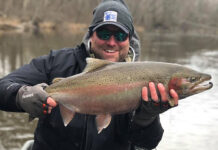>I had an opportunity to travel with the Ohio State University Extension sheep team to Australia March 24 –April 9. Our group of 17 consisted of sheep farmers, extension educators, and extension specialists.
Australia visit. We had the opportunity to visit a number of sheep farms, a few dairy farms, a couple of vineyards and orchards, a large sheep processing plant, a wool processing plant and other businesses related to the sheep industry.
Most of our touring was done in the state of New South Wales. Looking at the trip down under from a livestock grazier’s perspective; here are some of the lessons I learned, and impressions that I came away with.
Lessons learned. One of the first things I learned was that the size of most sheep operations in Australia is large-scale. Farmers manage thousands of heads of sheep and thousands of acres of crops and pasture.
We were amazed to learn that in Australia, one labor unit is assigned to handle five to six thousand head of sheep! The largest farm we visited was composed of about 80,000 acres divided between crops and pasture, with 60,000 head of sheep.
Important tool. Grazing is an important management tool and livestock (both sheep and beef) are expected to survive mainly through grazing. Livestock are managed as a flock or herd with very minimal attention given to individual animals.
Those animals that don’t match up with the environment are culled from the herd or flock. Records are kept and animal performance is tracked. The majority of the sheep farmers we visited expected lambs to reach a weaning weight of 85 to 90 lbs in 100 to 120 days on pasture alone.
One farmer that we visited that had 80 head of cattle along with 4,000 head of sheep, showed us a pen of 16 month old black angus bulls that had averaged between 4.5 to 5.5 pounds of gain/day on pasture.
Forages used. Forages used in the pasture system included orchardgrass, annual ryegrass, a species of canarygrass, subterranean clover, red clover and alfalfa. The Australian terminology for some of these forages was different than our common useage.
For example, orchardgrass is cocksfoot, canarygrass is phaleris, and alfalfa is called lucern. The grass and clover pastures were most often the permanent pastures, while the alfalfa pastures were used for 2-3 years as part of a cropping system rotation. In some pasture management systems, the permanent pastures were over seeded each fall with an annual ryegrass that would grow during the cooler part of the year.
Management challenges. This was accepted as a cost of doing business. We were surprised to learn that on many farms, soil fertility, especially soil pH is a management challenge. We visited with several farms where the soil pH was in the 4.2 to 4.5 range before lime was applied. On some farms, the farmer feels fortunate when enough lime can be applied to increase soil pH into the 5.5 range! It made me consider the common 5.5 to 5.7 soil pH’s that I see in Athens County in a whole new light!
One aspect of the grazing system that was unexpected, at least for me, was the level of intensity. Before traveling to Australia, I had this image of farm after farm using management intensive grazing, using lots of pasture divisions with frequent paddock moves. I didn’t see this as our group traveled to farms in the state of New South Wales.
Observations. As we traveled and looked at pastures and livestock from the van window, it certainly appeared that more paddock divisions could be added, along with water systems. The observations made on farms we visited as well as conversations with those farmers indicated more extensive grazing management.
In other words large acreage paddocks, large numbers of livestock in those paddocks and multiple days in those paddocks. My perspective was that most large livestock farmers were not going to move several thousand animals to a new grazing paddock every day or even every couple of days.
Of course, it could be that I just didn’t have a correct perspective of pasture management when livestock on pasture are in groups in excess of several thousand head. The cattle, sheep and lambs that we saw all looked to be in very good body condition.
The rates of gain that farmers told us they achieved on pasture also supported the notion that whatever system of pasture management was being used, it was effective. The grazing ability of sheep was actually an important component of the cropping system in the area we traveled.
Sheep were used to graze wheat stubble. This resulted in weed control, particularly of ryegrass, and reduced the alleopathic influence of wheat stubble on the canola crop that followed wheat in the typical crop rotation. I realize that the majority of the farms and agriculture businesses we had the opportunity to visit represented the upper level of the agriculture industry. It was interesting that during the course of these visits some common themes and characteristics of these farmers and managers began to emerge.
Common themes. Some of those common characteristics between the Australian farms visited included: Vision: All of these farmers had goals and knew where they were going, what they wanted to accomplish, and what they needed to do to get to where they needed to be.
All of them had a passion for their business.
Management: All of the farms we visited exhibited excellent management skills and dedication to developing management skills.
Record keeping: All of the farms depended upon records. They measured what was important to them and recorded that information. Those records were used to make management decisions.
Flexibility: None of the farms were tied to a specific number of animals. They were flexible depending upon weather patterns. Their identity was not tied up with a number.
Sheep were managed as part of an integrated farm system. As I look at these common characteristics, I recognize that these are some of the things that we talk about in our grazing schools and characteristics that many of our top graziers have developed.
Traveling to view and learn about the agricultural systems in another country is a privilege and an eye-opening experience. Lessons can be learned and I’m sure as I go through this grazing season here in Ohio, I will reflect back upon conversations, sights and experiences of my time in Australia.












